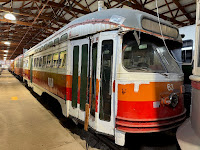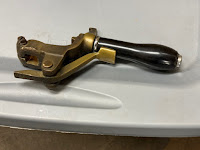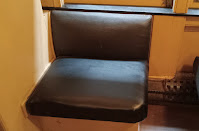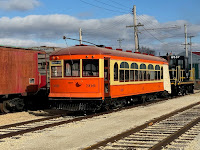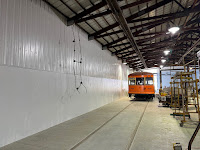For Wednesday we have a wide variety of activities to report, so pull up a chair. On the way to the Museum, I stopped at the Sherwin Williams store in Huntley to pick up the recently matched paint for the
Shaker Heights PCC 63. As Frank reported last time, he's agreed to give it a cosmetic paint job.
It's a nice color, and when Frank is finished it will certainly look a lot better than it does now.
And speaking of paint, here we see Pete finishing up the brand new baggage door for the 213. This may be the biggest door the Car Dept. have ever fabricated.
Buzz was working on parts for the Pennsy tool car:
And Tim was installing clerestory windows on the 1808, using the magic lift.
Also, some structural repairs have been made.
Many other people were busy - Fritz, Victor, Bill, Tim, Bob Albertson, Marcus, and several more, but I wasn't fast enough with the camera.
I kept working on seats. In the 319, there are several that are basically in good shape, but could be improved with a coat of black latex. Here's a typical "before" subject.
So I painted several backs and a couple of cushions. It's going to look much better.
I also finished tightening up all the screws in the backs that were installed last time.
Now for another upholstery project -- this one is a little more challenging. Here is what the seat backs in the 36 look like. They are covered in rattan (a special type known as "transit weave") and have two horizontal insets on each side:

...except for three of them, which were replaced with these flat backs at some point. Instead of rattan, this is actually some sort of plastic and doesn't look at all right. Besides being flat, the backs are too high, so they stick out like sore thumbs. And we didn't get any spare parts with the 36, so I'd like to try to make some new ones.

The seat backs in this car are not held in place with screws or anything similar; instead, wedge-shaped castings on the backs and the brackets fit into each other. With enough leverage, you can lift the back straight up and out. Perhaps you can see the casting on the side of the back:
A close-up:
Notice how the pseudo-rattan is coming loose.
From measurements, it appeared that the seat backs in the 300 and similar cars are just about the right size and shape. Of course, they're covered in fabric, not rattan, but perhaps that can be corrected. I had taken home a 300 seat back that was in bad condition and started removing the fabric just to see what was underneath. But here it is propped up in place. You have to use your imagination, but it should fit right in. It may appear a little too short, but that's because it's sitting on the cushion and not supported two inches higher for clearance like the actual seat backs.
Several years ago we acquired a couple of rolls of transit-weave rattan, and there should be plenty for this project. Tim's expertise will be critical for success. He has suggested starting off with a small test piece for practice. I've got a few spare nickel seats that should be just right.
But that's not all. I also brought home a seat cushion from the 309 to recover. There's always something that needs to be done, so it never gets dull. Watch this space for results!
